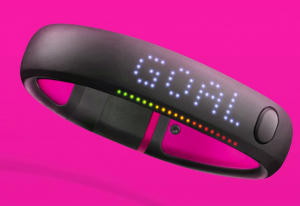Self tracking
Original Editor - Tony Lowe
Top Contributors - Tony Lowe, Lucinda hampton, WikiSysop, 127.0.0.1 and Kim Jackson
Definition[edit | edit source]
Types of device and app[edit | edit source]
Activity trackers - generally the record number of steps taken but also can record elevation gained (number of stairs and floors). Often also estimate a measure of calories burned. Examples include the Fitbit, Nike Fuelband, Jawbone Up,Striiv and Withings Pulse. Mike Reinold provides a PT's review of these devices.
Meal logging - record daily food intakes through the use of photos odf meals, databases of food types and quantities to estimate calories and nutrients (e.g. the Fitbit food database) and even food scanners to automatically estimate meal make up (e.g. the TellSpec scanner).
Symptom logging - record symptoms such as pain and send reports to healthcare professionals (e.g. Manage my pain app).
Sleep tracking - measures activity levels and sometimes body temperature and heart rate at night to identify sleep good and bad patterns.
Body health measures - heart rate, skin temperature, perspiration (e.g. the Basis watch), blood pressure (e.g. the iHealth blood pressure monitor), blood oxygen saturation (e.g. the iHealth Pulse Oximeter), heart ECG trace (e.g. Alivecor)
Examples of medical use[edit | edit source]
Implications for physical therapy / physiotherapy management[edit | edit source]
- Setting appropriate goals for patient daily exercise levels (e.g. setting an appropriate daily goal for number of steps taken).
- Patient logging of subjective measures for review during consultations e.g. pain, energy levels, feeling of wellness etc.
- Logging daily prescribed exercise completion.
- Setting goals and warning levels for measures with prompts for patients to seek medical attention or return for a follow-up appointment when these are met.
Recent Related Research (from Pubmed)[edit | edit source]
Failed to load RSS feed from http://www.ncbi.nlm.nih.gov/entrez/eutils/erss.cgi?rss_guid=1RsSBuK-apTRuDNIn1bqVDWoNr-FTW_Lq4RVSQHfCbd8t115xy|charset=UTF-8|short|max=10: Error parsing XML for RSS
References
[edit | edit source]
- ↑ Hansen, Dr. Margaret M., "Self-Tracking, Social Media and Personal Health Records for Patient Empowered Self-Care" (2012). Nursing and Health Professions Faculty Research. Paper 17.fckLR(http://repository.usfca.edu/nursing_fac/17)
- ↑ Kurti AN, Dallery J., "Internet-based contingency management increases walking in sedentary adults.", J Appl Behav Anal. 2013 Fall;46(3):568-81. doi: 10.1002/jaba.58. Epub 2013 Aug 1.
- ↑ Renée V.,Van der Weegen, S., Spreeuwenberg, M., Tange, H., Van der Weijden, T & Witte, L., A Monitoring and Feedback Tool to Support Patients in Achieving a more Active Lifestyle, eTELEMED 2012 : The Fourth International Conference on eHealth, Telemedicine, and Social Medicine (http://www.thinkmind.org/index.php?view=article&articleid=etelemed_2012_6_40_40086)
- ↑ J. Adam Noah, David K. Spierer, Jialu Gu, and Shaw Bronner, Comparison of steps and energy expenditure assessment in adults of Fitbit Tracker and Ultra to the Actical and indirect calorimetry, Journal of Medical Engineering & Technology, October 2013, Vol. 37, No. 7 , Pages 456-462 (http://informahealthcare.com/doi/abs/10.3109/03091902.2013.831135)
- ↑ Takacs J, Pollock CL, Guenther JR, Bahar M, Napier C, Hunt MA., Validation of the Fitbit One activity monitor device during treadmill walking., J Sci Med Sport. 2013 Oct 31 (http://www.ncbi.nlm.nih.gov/pubmed/24268570)







